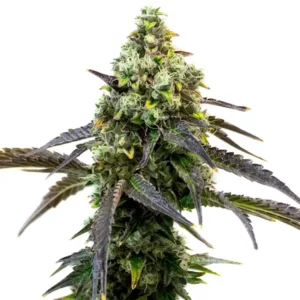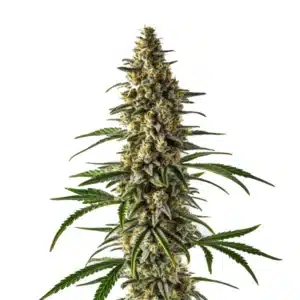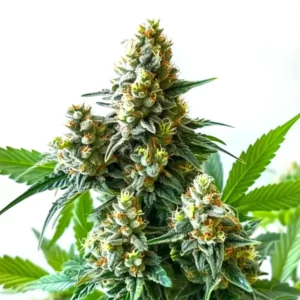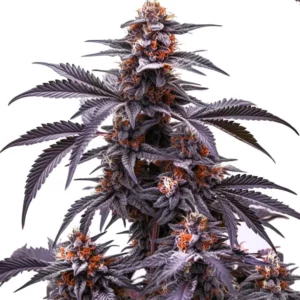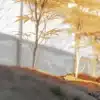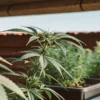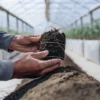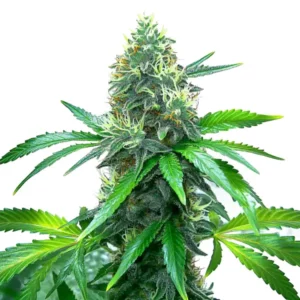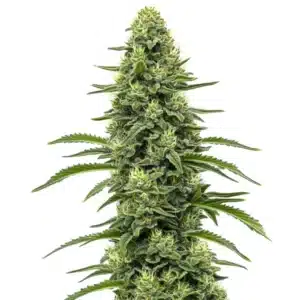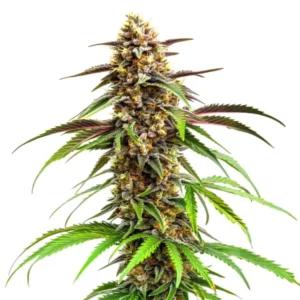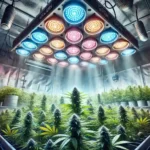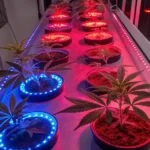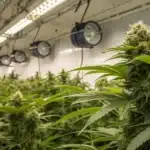
How to Use Blue Light to Shape Cannabis Growth
Light is crucial for cannabis growth, and blue light has some unique benefits. Blue light is part of the visible spectrum, with a wavelength range of 450–495 nanometers. It plays a vital role in shaping plant development, especially during the vegetative stage. Knowing How to Use Blue Light to Shape Cannabis Growth allows growers to control plant height, encourage stronger stems, and optimize leaf structure for better yields.
When you’re growing cannabis, you want the best possible yield. Using blue light to enhance cannabis yield is an effective strategy. It influences how cannabis plants grow, affecting everything from leaf development to overall plant structure.
Recommended Strains
GG4
|
|
THC | 27% (High) |
|
|
Type | Feminized |
|
|
Yield | High |
|
|
Phenotype | 40% Indica / 60% Sativa |
Blue Dream
|
|
THC | 17% - 24% (Medium) |
|
|
Type | Feminized |
|
|
Yield | High |
|
|
Phenotype | 50% Indica / 50% Sativa |
Knowing the blue light spectrum for cannabis growth helps you make informed decisions. By applying the correct blue light settings for your grow setup, you can optimize your plants’ growth and health.
Benefits of Blue Light in Cannabis Cultivation
Blue light encourages robust plant growth. It enhances the development of leaves and stems, leading to a healthier plant. Cannabis plants exposed to blue light often have thicker, sturdier stems, which support more substantial foliage. Knwoing How to Use Blue Light to Shape Cannabis Growth helps growers maximize these benefits, guiding plants toward stronger structures and improved yields.
Another benefit of blue light in cannabis cultivation is the impact on photosynthesis. Blue light is absorbed efficiently by chlorophyll, the pigment in plants that aids in converting light into energy. This process is essential for vigorous growth and high yields.
The benefits of blue light in cannabis cultivation extend to improving plant resilience. Plants exposed to adequate blue light conditions tend to be more resistant to environmental stressors, such as temperature fluctuations and pest attacks. This resilience ensures that the plants can continue to thrive even in less-than-ideal conditions.
Moreover, integrating blue light into your cultivation practices can aid in the production of essential oils and terpenes. This not only enhances the plant’s aroma and flavor profile but may also increase its medicinal properties, making blue light a valuable tool for growers focused on quality and potency.
Promos & Deals
Blue Light Spectrum for Cannabis Growth
The blue light spectrum for cannabis growth is crucial during the vegetative stage. During this phase, plants require more blue light to develop strong roots and stems. This light spectrum mimics the natural spring sunlight, promoting bushy plant growth.
By using the blue light spectrum effectively, growers can control the plant’s structure. Plants receiving adequate blue light tend to grow shorter and bushier, which is ideal for maximizing space and light exposure in indoor growing environments.
Knowing the blue light spectrum for cannabis growth allows growers to fine-tune their lighting systems to suit specific growth stages. This precision enables the cultivation of plants with enhanced vigor and uniformity, crucial for achieving consistent yields. Adjustments to the blue light spectrum can also be tailored to specific strains, further optimizing growth outcomes. Knowing How to Use Blue Light to Shape Cannabis Growth helps growers apply these principles effectively, ensuring healthier plants and improved bud quality.
Incorporating the blue light spectrum for cannabis growth into multi-spectrum lighting systems can also improve the overall quality of the plant’s development. A balanced approach ensures that blue light works harmoniously with other wavelengths, such as red and far-red light, to support both vegetative and flowering stages, ultimately leading to healthier plants.
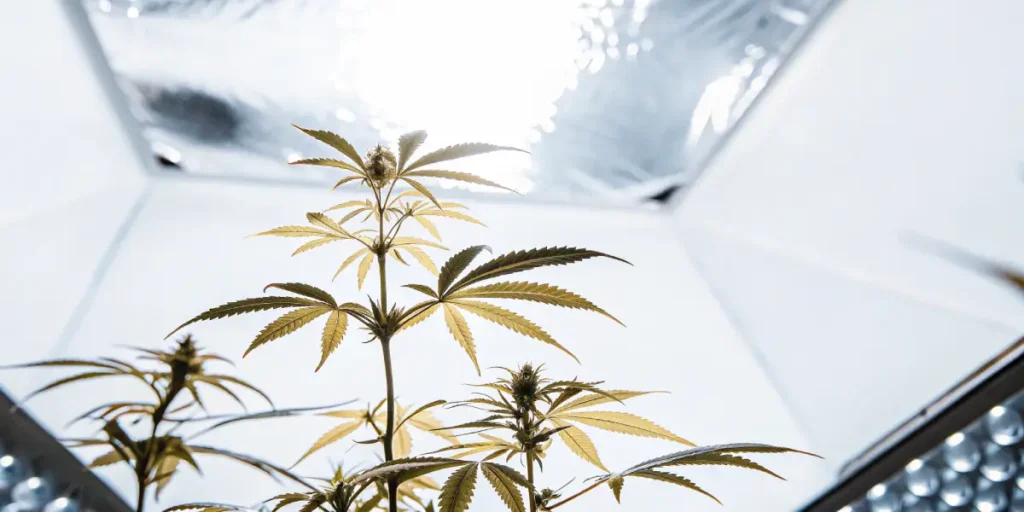
Optimal Blue Light Settings for Cannabis Plants
Setting up the correct blue light levels is crucial. During the vegetative stage, aim for around 20–40% blue light in your grow lights. This ratio encourages healthy leaf and stem development without overstimulating the plants. Knowing How to Use Blue Light to Shape Cannabis Growth helps growers optimize structure, promote compact plants, and prepare them for stronger flowering later on.
Adjusting the blue light settings based on the cannabis strain can also be beneficial. For instance, strains like Blue Dream from Blimburn Seeds thrive under optimal blue light conditions, resulting in lush growth and robust plant structure.
Determining the optimal blue light settings for cannabis plants involves knowing the unique needs of each strain. While some strains require higher blue light intensity, others may thrive with a more moderate approach. Continual monitoring and adjustment of these settings can lead to improved growth patterns and increased yield potential.
Another factor in determining optimal blue light settings for cannabis plants is the integration of blue light with other light spectrums. A well-balanced light environment can support the plant’s overall health, ensuring that each stage of growth is met with the appropriate energy levels for maximum productivity.
Impact of Blue Light on Cannabis Plant Development
Blue light impacts cannabis plant development significantly. It influences everything from leaf size to stem thickness. By customizing the light spectrum, you can encourage specific growth patterns, leading to healthier plants.
For example, Cannabis strains like GG4 from Blimburn Seeds exhibit enhanced growth when exposed to blue light during their vegetative stage. This exposure results in a sturdy structure capable of supporting more buds.
The impact of blue light on cannabis plant development also extends to the plant’s nutritional uptake. Blue light has been shown to promote the absorption of essential nutrients, such as nitrogen and potassium, which are vital for robust growth. This enhanced nutrient uptake contributes to the plant’s overall vitality and productivity.
Furthermore, the impact of blue light on cannabis plant development includes an effect on the plant’s internal clock. Blue light can help regulate the plant’s circadian rhythm, optimizing growth cycles and ensuring that energy is used efficiently throughout the day and night, further enhancing the plant’s growth potential.
Using Blue Light to Enhance Cannabis Yield
Using blue light to enhance cannabis yield is a practical approach. By incorporating blue light into your grow setup, you can optimize the photosynthesis process, leading to increased energy production and, ultimately, higher yields.
Strains like Girl Scout Cookies from Blimburn Seeds benefit from blue light exposure, resulting in a denser canopy and more prolific flowering. This strain is known for its potent effects and rich flavor profile, making it a favorite among growers.
Incorporating blue light to enhance cannabis yield also involves strategic planning of light cycles. By adjusting the timing and duration of blue light exposure, growers can encourage plants to focus their energy on bud production, leading to more abundant harvests.
Moreover, using blue light to enhance cannabis yield can also improve the quality of the final product. The increased energy production supports the development of more potent buds with higher concentrations of cannabinoids and terpenes, making the use of blue light a win-win for both yield and quality.
- Blue light encourages strong root and stem development.
- Improves photosynthesis efficiency, boosting growth.
- Helps maintain compact plant size, preventing stretching.
- Enhances leaf size and thickness, supporting overall plant health.
- Contributes to increased cannabis yield by optimizing energy production.
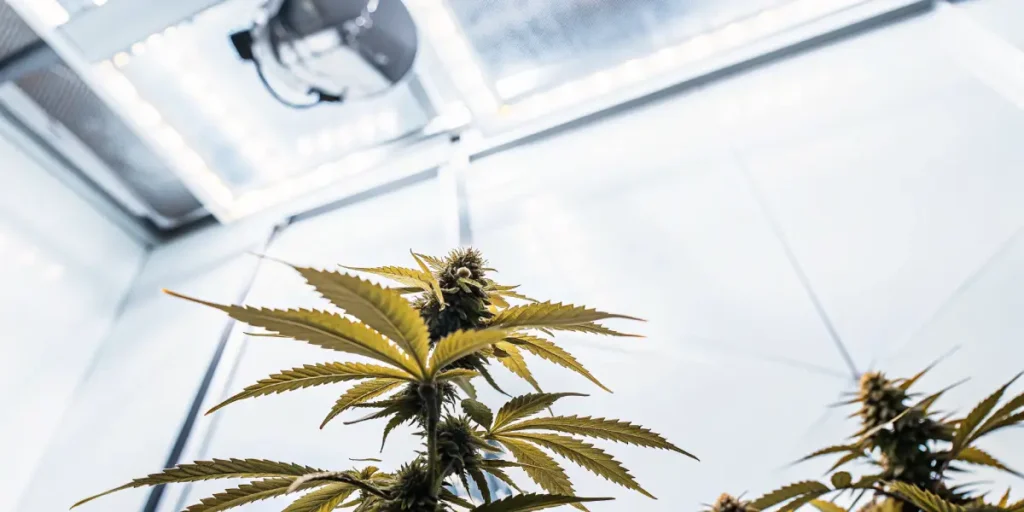
FAQs
What is blue light, and why is it important for cannabis growth?
Blue light is a part of the visible spectrum with wavelengths between 450-495 nanometers. It plays a crucial role in cannabis growth, particularly during the vegetative stage, by promoting robust stem and leaf development.
It enhances photosynthesis, the process by which plants convert light into energy. This is vital for healthy growth, making blue light an essential component of an indoor grower’s lighting setup.
Knowing how to use blue light to shape cannabis growth can lead to more efficient grow operations. By tailoring the blue light exposure to the plant’s specific needs, growers can optimize plant health and productivity, ensuring a successful harvest.
Moreover, blue light’s importance in cannabis growth extends to its role in maintaining plant morphology. By encouraging compact and sturdy growth, blue light helps growers manage plant height and structure, which is especially beneficial in indoor cultivation settings.
How does blue light affect cannabis plant structure?
Blue light affects the structure by encouraging shorter, bushier growth. This is beneficial for indoor growers looking to maximize their space and light exposure. Plants exposed to blue light typically have thicker stems and larger leaves.
This compact growth pattern results in a sturdier plant structure, which can support more buds during the flowering stage. It’s a key factor in shaping cannabis growth for optimal yields.
The impact of blue light on cannabis plant structure also includes the development of more robust root systems. Stronger roots provide better nutrient uptake and support for the plant, leading to increased stability and resilience throughout its lifecycle.
Additionally, blue light can influence the density of the plant’s foliage. Denser foliage not only improves photosynthesis efficiency but also provides a protective canopy that can shield the plant from environmental stressors, enhancing overall plant health and yield potential.
Can blue light be used throughout the entire growth cycle?
While blue light is most beneficial during the vegetative stage, it can also be used throughout the growth cycle. However, it should be balanced with other light spectrums, like red light, during flowering to optimize bud production.
Maintaining a proper balance ensures that the plants receive adequate energy for both vegetative growth and flowering, leading to a successful harvest.
Using blue light throughout the entire growth cycle requires careful calibration of light intensity and duration. This approach, when combined with red and other spectrums, can lead to a more harmonious growth environment, fostering both vigorous vegetative growth and prolific flowering.
Furthermore, using blue light strategically throughout the growth cycle can support the plant’s natural physiological processes. This holistic approach to lighting ensures that each stage of the plant’s development is optimized for maximum yield and quality.
What are the optimal blue light settings for different cannabis strains?
Optimal blue light settings can vary depending on the strain. For instance, strains like Blue Dream and GG4 from Blimburn Seeds respond well to higher blue light levels during vegetative growth.
It’s essential to research each strain’s specific needs and adjust the blue light settings accordingly to maximize their growth potential and yield.
Determining the optimal blue light settings for different cannabis strains involves knowing the genetic characteristics and growth preferences of each variety. By leveraging this knowledge, growers can fine-tune their lighting setups to provide the ideal conditions for each strain.
Additionally, experimenting with different blue light intensities and durations can help identify the perfect balance for each strain, leading to improved growth patterns and increased yields. This customization is key to successful cannabis cultivation.
How can I integrate blue light into my current grow setup?
Integrating blue light into your grow setup is straightforward. Consider using full-spectrum LED lights that allow you to adjust the blue light intensity according to the plant’s growth stage.
Start with a higher blue light percentage during the vegetative stage and then balance it with red light as the plants transition to flowering. This approach ensures optimal growth and development throughout the plant’s life cycle.
When integrating blue light into your grow setup, it’s important to ensure that your lighting system is adjustable and versatile. This flexibility allows you to adapt to the plant’s changing needs and optimize growth conditions as the plant progresses through its life cycle.
Another consideration when integrating blue light is the layout of your grow space. Positioning lights strategically can maximize light coverage and penetration, ensuring that all parts of the plant receive adequate illumination for healthy growth.




